Earlier this year, I bought a brand new PRS Paul’s Guitar.
So what do I think of it? What does it sound like? And why exactly has it taken four whole months to write up my First Impressions?
This is a lengthy post, so grab a fresh drink before you dive in 🙂
tl;dr
I bought a PRS Paul’s Guitar, as a present to myself for an upcoming milestone birthday.
To get the best out of this guitar, I had to do a lot of troubleshooting with my rig, That’s taken several months, and (as you’ll hear) there’s still more to do.
This is a very versatile guitar. If you split the neck pickup, it can do the Strat thing. If you split the bridge pickup, it can do the Tele thing. And the bridge humbucker does an absolutely killer P90 impression.
For me, though, the magic lies in between – in the middle position, with one pickup split and the other as a humbucker. That’s where I plan on using it the most.
Table of Contents
- tl;dr
- Why Have You Waited So Long To Publish These First Impressions?
- What Did You Buy?
- Why Did You Buy It?
- Why A Paul’s Guitar?
- Can You Tell Us About The Fit And Finish?
- Yes Yes, But Tell Us About The Sound
- This Guitar Has Challenged My Home Rig
- What Is Your Signal Chain Today?
- Let’s Talk About Those Pickups
- Neck Single-Coil Tones
- Bridge Single-Coil Tones
- Both Pickups Single-Coil Tones (aka The Middle Position)
- Neck Pickup Humbucker Tones
- Bridge Pickup Humbucker Tones
- The Magic Is In The Middle, With One Pickup Split
- If You Don’t Have An Axe FX 3
- Does It Have A Name Yet?
- Final Thoughts
Why Have You Waited So Long To Publish These First Impressions?
The normal idea with these First Impressions blog posts is to try and publish them after no more than a day or two with whatever new (to me) gear I’m writing about. That way, I can look back at some point and see how my opinion has changed as I’ve grown more familiar with the gear in question.
This time, though, I needed more time. There’s been a couple of things that I needed to understand first.
Grounding Needed Fixing, And Shielding Needed Adding
Sadly, the guitar had to go into the shop for some work. As Peach Guitars is the other side of Britain to me (and I’ve no intentions of returning the guitar), I had the work done at my local PRS dealer instead at my expense.
When I play, there’s a crackling sound when I touch the strings. It also does this when I touch the back of the tuners. I had it into my local PRS dealer to take a look, and they did what they could, but the problem hasn’t totally gone away. You’ll be able to hear it happening on the audio demos further down.
The remaining crackling problem is probably down to something in my signal chain not being fully-grounded. I’ve been advised that it’s likely to be the old wiring in this house.
I’ve since discovered that this isn’t the only guitar I’ve got that does this, it’s just the first guitar that I’ve noticed this on – and by far the guitar where it’s the most noticeable. (For everyone who calls out Gibson for QC issues, I note that my Les Paul does not have this crackling problem at all …)
When I popped the back plate off to look inside, I was surprised to find that there’s no sign of any shielding in there. (I’m told the pickup cavities are also unshielded.) That … seems like a big oversight for a guitar with true single-coil noise.
So while it was in the shop for the grounding issues, I had shielding paint added inside the guitar. I think it’s made a difference, but I don’t have any before-and-after recordings to refer to to be sure.
This work took a bit of time.
I’ve Had Tone Problems In My Rig
When I first got the Paul’s Guitar, it was all-bass and no treble. While some of that was down to a problem with the electronics (which I’ve discussed above), much of it was due to my rig at the time.
This was caused by two separate problems:
- I’ve accidentally been using two power attenuators at the same time: my Fryette PS-100 Power Station, which was then running into my Two Notes Captor by mistake. This coloured the final sound a surprising amount.
- The home-made cables in my studio rack were both adding noise and cutting treble. Thankfully, not every signal path used these cables – just the ones involving my Synergy amp or my audio interface. These have now been replaced.
Once I found this, I had to throw away the entire ‘how it sounds’ section of this blog post and start again. It was worth doing; my thoughts on the tone have changed a lot, especially the neck pickup.
What Did You Buy?
I bought a brand new PRS Paul’s Guitar from Peach Guitars.
The Paul’s Guitar is the signature guitar of Paul Reed Smith (Mr PRS) himself. It’s the guitar that he designed for his personal needs as a musician. If memory serves, the original design was briefly in the PRS lineup in 2013, and by 2017 it had largely disappeared. PRS brought it back as a regular production model in 2019, although examples in the shops are still frustratingly rare.
Mine was made in 2020.
As far as I know, the main difference between the 2020 models and the older 2013 version is the pickups. These new models feature the TCI version of the narrowfield pickups. TCI is reported to be a process that allows PRS to ‘tune’ the pickups. I haven’t seen any information about whether the pickups are tuned to always be identical (ie to reduce / eliminate manufacturing variances), and/or whether the pickups are tuned to suit the individual guitar they’re going in.
Why Did You Buy It?
My next birthday is a milestone one, and I wanted to find a very special guitar to mark the occasion. I’ve been looking for something for the best part of a year.
What Guitars Were You Considering?
A Gibson made-to-measure (M2M for short) would have been the obvious choice.
Regular readers will know how much the Les Paul is the guitar for me. While an R8 would have been an option, what I’d really love is a Les Paul with a P90 in the neck and a humbucker in the bridge. That would be a very special guitar indeed.
The problem with Gibsons is that the great ones all have their own voice – and it’s a very personal thing. A M2M would simply have been too much of a lottery. There’s no way of knowing in advance whether or not I’d love the tone of the final guitar. I didn’t want to take the risk of being disappointed with this guitar.
What about a Custom Shop Fender, perhaps? I’ve finally played a few, and I’m impressed by them. Honestly, it’s hard to play a regular Fender once you’ve spent time with a Custom Shop Telecaster or Stratocaster. The gulf in both sound and playability between Fender Custom Shop and their factory-line models really surprised me – and it isn’t something that can be fixed simply by after-market electronics, no matter what anyone tells you.
Unfortunately, I don’t get on with Fender’s vintage specs at all, and I don’t play Strats regularly enough to remotely justify getting a Custom Shop version.
Kristi and I had long discussions about going with a really nice acoustic from someone like Brook Guitars. An acoustic would get a lot of use, for sure. At the end of the day, though, I’m an electric guitar player at heart. And with acoustic guitars, I’ve found that I’m very much a one-guitar kind of person. My Auden suits me perfectly, and always has, right from the first notes I played on it.
I’ve been having this conversation on and off for about a year now, and it’s always circled back towards me ordering a Telecaster from the Custom Shop. Regular readers (and friends on socials) may have noticed that I played Telecasters and Esquires a lot in 2021. Ordering one (rather than getting one off the peg) would have allowed me to have one with modern appointments (accessible truss rod! saddles that intonate and don’t shred my hand! oh the bliss!), and it would definitely get played a lot.
Then, at the start of February, Hedgehog got its new pickup. That changed everything.
Why Did You Pass On A Telecaster?
Spending so much time with my Telecasters – and really getting into detail for a bunch of #TeleTuesday blog posts – I started to notice a few things that had always been there, but that I’d glossed over before.
- None of my Telecasters or Esquires intonate all that well. I play a lot of open chords, and they’re often out the most. I know some of that is my technique. It’s still tiring and frustrating, when all I want to do is enjoy myself.
- The one Telecaster that does intonate well enough is my old American Deluxe … the one that doesn’t have the brass barrel saddles. Unfortunately, I prefer the sound of the brass saddles. A Tele just isn’t a Tele without them.
- I don’t find the ergonomics very comfortable. For example, I was noticing that I don’t like how the body of a Telecaster feels when it’s pressed up against me. It just feels too big. I also don’t like how I’ve got to force my shoulders further back to accommodate the longer scale length. That gets tiring after a few hours. (It’s fine when standing. It’s just noticeable when playing sat down.)
- Doing the pickup comparisons for the TeleTuesday blog posts, it was just too much Telecaster tone in one solid block. I enjoy the sound in small doses, but it’s not like my Les Paul or my McCarty 594. Those are guitars that I can play all day and love them even more at the end of it.
I can still imagine me placing that Custom Shop Telecaster order one day. This time round, it just didn’t feel like a Tele was the right choice for me to mark this milestone birthday. And (although I didn’t know it at the time), the Custom Shop’s backlog is currently far too long for the guitar to have any chance of arriving before the birthday after my milestone birthday.
You Haven’t Mentioned PRS Private Stock
There was never any thought of me ordering a PRS Private Stock guitar.
I’ve been fortunate enough to play quite a few (thanks Andrew and Jez!). They’re both amazing instruments and amazing works of art. Seriously, if you ever get the opportunity, go and play a Private Stock guitar – even if you’ll never be able to afford one. I found the experience to be a good education.
Sadly, they’re just too blank a canvas for me.
To get the best out of a Private Stock instrument, you need both the chops and tone in your fingers to die for. I have neither. I need a guitar that has a bit of character for me to lean on. In terms of the PRS lineup, Core or Wood Library models are a much better fit for me.
I first learned that lesson several years ago, when I bought Deadnote (my beloved PRS McCarty 594). It was a straight choice between Deadnote and the Private Stock version of the McCarty 594. I got to spend quality time with both of them, A/B’ing back and forth, and while the Private Stock version was incredible (solid Brazilian rosewood neck! I’ve never heard a guitar ring like that one did!), it was Deadnote that worked better for me.
Why A Paul’s Guitar?
I’ve been interested in trying a Paul’s Guitar for several years, because they’re something a little bit different.
- They’re not chasing the sound of a great Les Paul, nor the sound of PRS’s own heritage.
- They’ve got the 408-style switching (which is PRS’s second best control layout; the 594 has the best), which makes them more versatile than your regular Custom 24.
Unfortunately, they’re also really hard to find here in the UK. The pandemic meant that it was well into 2021 before the 2020 models started to show up here at all, and I’ve seen less than a dozen go on sale in the whole time I’ve been looking for one.
I was about to give up on one … and then I heard this:
(Peach Guitars started publishing individual videos of individual higher-end instruments during the lockdowns, to help choose a guitar while they were unable to visit the store to try one in person.)
The character of that tone really caught my attention.
I pulled up some other YouTube demos of Paul’s Guitars (including all the others I could find of Jack playing), and this one continued to impress. It’s a bit risky to read too much into one video, but as far as I could tell, this particular Paul’s Guitar has its own voice.
It took me a while to realise that it was an old video. Jack had filmed and posted it months before I came across it. Given how quickly Paul’s Guitars sell, I thought I’d missed out. No, not at all. The guitar in that video was still hanging on the wall at Peach Guitars. It had been there for almost a whole year, and somehow hadn’t sold.
And now it’s sat on my lap while I’m writing this up.
Can You Tell Us About The Fit And Finish?
What Is The Build Quality Like?
In short: very very good.
The most important news: no dead notes anywhere on the fretboard. Dead notes are a thing that happens from time to time with PRS guitars (which is why my McCarty 594 is named Deadnote). That’s a huge relief, because I would have been gutted if I’d had to send this back.
There’s a tiny ding in the neck by the fourth fret. I can’t feel it, but it does catch the light quite strongly. I can’t tell if it’s under the lacquer (so, a factory defect) or something that happened before it reached me.
There’s also a couple of odd circular spots in the flame maple top, under the lacquer. They have the appearance of small holes that have been filled. I’m sure they’re not. They just look a bit off, as if they’re not a natural part of the wood figuring. I don’t notice them from any sort of distance.
What Is The Flame Maple Top Like?
This is one of those flame maple tops that looks different at different angles. I’m very pleased with that.
Head on, it’s got very wide flames, coming close to turning into a quilt top in places. It makes a very nice change from the almost cliché flame maple tops found on showpiece Gibsons (yes, and PRS’s too!).
There’s some movement in the flames, but not a lot. If that’s really your aesthetic, you might be disappointed. I’m pretty happy with it.
What Is The Neck Like?
This Paul’s Guitar has quite a chunky neck. It’s chunkier than the necks on my McCarty 594 or my Custom 24. I’d say it’s closer to the neck on my Les Paul R9 than anything else I’ve tried. It’s not a fat neck, it just fills the hand a little more than PRS’s other neck carves. I find it very comfy to play, but I do sometimes get hand cramp after I’ve stopped playing.
The good news is that the lacquer on the back of the neck isn’t sticky. I’ve played the guitar a lot since I got it, and so far, I’ve had no problems there at all. It’s not glassy hard, but as long as it isn’t grabby, I’m happy (and relieved).
(I’ve found that PRS lacquered necks can sometimes be soft or sticky in the hand. It seems to be a complete lottery as to whether or not any individual guitar has a sticky neck or not. It’s not a problem I’ve had with Gibsons or Fenders.)
What Is The Fretboard Like?
I’m one of these people who never notices how the fretboard feels under the fingers. All I can do is comment on how it looks, sorry!
This is the first guitar I’ve owned that’s had Honduran rosewood, and I’ve got to say it’s very easy on the eye. In many ways, it reminds me of the laurel fretboard that’s on Hedgehog, if a bit lighter in colour and far more open-pore.
The brushstroke bird inlays are very nice to look at. They’re a little different in shape to the standard birds on (say) a Custom 24; they’re not just a brushstroke version of the exact same bird inlays. They’re a classy touch.
What Are The Frets Like?
The best complement I can give is that I haven’t noticed the frets at all while playing. Those are the kind of frets that I like 🙂
By eye, the frets look slightly wider than the frets on my McCarty 594 or my Custom 24. They definitely look flatter, which might just be a fret dressing thing?
The fret ends are rounded to total perfection. I’ve had plenty of guitars with nicely rounded fret ends, including Wood Library PRS guitars. These are on another level.
What Is The Bridge Like?
The Paul’s Guitar comes with a single wrap-around tail piece that has non-adjustable intonation.
The strings sit at a nice height on top of the bridge. I’ve had no difficulty at all with controlling tone or muting strings with my right-hand technique. In that respect, I’ve found it no different to play to the two piece bridge and tail piece on my McCarty 594.
Where the tail piece fastens to the bridge studs, that tapers to a sharp edge. I’ve already caught my hand on that a few times. This is the only part of the guitar’s design that I’m finding outright annoying and baffling.
I don’t have any experience with this kind of bridge before, so I don’t know whether a non-adjustable bridge like this will be a problem as time goes on. I expect it to be, as the nut wears down. I’ll report back in 10 years or so 😂
What Is The String Action Like?
I’d describe as a little high … more like a Fender than a Gibson or any of the more mainstream PRS models that I’ve played.
Whether it came from the factory like this, or whether this is how Peach Guitars set it up before shipping it … I’ve no idea. It’s something that I’ll want to adjust at some point.
What Is the Intonation Like?
It’s a little off on a couple of the strings. And, because the bridge doesn’t have individual intonatable saddles, I’ve no idea whether this can be easily sorted or not.
Yes Yes, But Tell Us About The Sound
There’s a couple of important caveats to what you’re about to read. If you’re reading to help you decide whether or not to order a Paul’s Guitar without trying one first, please keep these in mind. Thanks!
I Can Only Tell Your About The Specific Guitar I Have …
I bought this specific Paul’s Guitar because (in the demos that I’ve heard while researching my purpose, including other demos made by Peach Guitars) it sounded noticeably different to any other Paul’s Guitar.
I’ve no hands-on experience with any other Paul’s Guitar; not the 2013 model, nor the 2019-present model with the new TCI pickups. For all I know, this guitar isn’t that unique an example.
… Through My Home Rig
As you’ll read in a moment, my home rig is almost certainly different to whatever rig you’re using. That’s going to have an influence on what I’m hearing and how I how feel about it. This same guitar through your rig will sound different, for sure.
This Guitar Has Challenged My Home Rig
One of the main reasons why it’s taken me months to write up my First Impressions is that this guitar has really been a spanner in the works.
The long and short of it is that my home rig was losing treble in a few places – and I only noticed when I got this guitar.
The single-coil / split pickup sounds from the Paul’s Guitar fall somewhere between the brightness of a true single-coil pickup and the fatness of a P90. They don’t quite have the same top-end and snap as a Tele or Strat pickup, while putting out a lot more low-end. The difference was just enough to show me that I had a problem with my rig.
I’ve ended up re-cabling my setup and getting my Gigrig G2 serviced, all to track down and sort out the treble loss that I was experiencing.
And (for reasons that I’ll demonstrate in a moment) I’ve also ended up switching over to an Axe-FX 3 rig, partly because of this guitar and the challenge I’ve had with its pickups.
What Is Your Signal Chain Today?
I’m using the signal chain that I’ve built specifically for this guitar:
- PRS Paul’s Guitar
- into the Axe FX 3
- into a Timmy drive model to shape the guitar’s tone (not always on)
- into an EQ block to shape the guitar’s tone (not always on)
- out of the Axe FX 3 to my Gigrig G2
- Ceriatone Centura klone pedal in one loop
- Snouse Electronics Blackbox Overdrive 2 in another loop
- back into the Axe FX 3
- into a Princeton amp model that I’ve tweaked to get pretty close to the clean channel on my Marshall DSL20HR
- into a noise gate
- into a pair of cab IRs that are similar to the Celestion A-Type and Celestion Blue that I use in my real 1×12 cabs
- into digital tape delay and digital spring reverb
- out to my audio interface
The Axe FX 3 Setup
I’m basically using the Axe FX 3 as a virtual pedal board before my real pedals, and then as a virtual amp and virtual FX pedals after my real pedals.

There are six scenes in the preset, which I’ve tailored for each of the different ways that this guitar can be used. The main differences from scene to scene are:
- whether the Timmy drive block is enabled or not
- whether the EQ block is enabled or not
- the EQ and bright switch settings on the amp model
My Choice Of Pedals
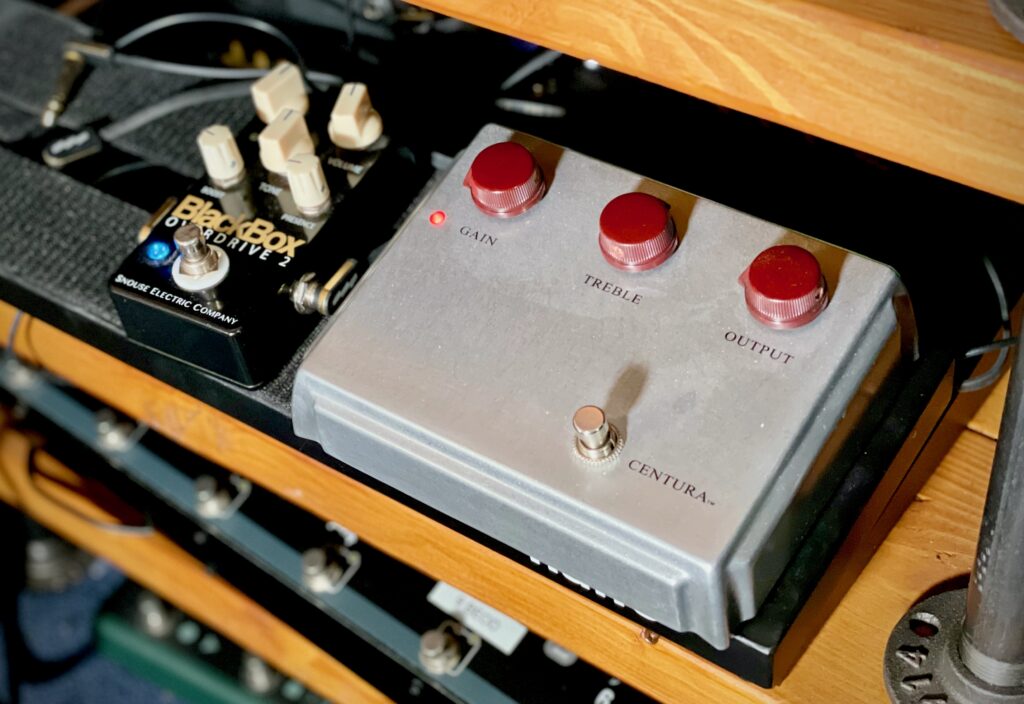
The Ceriatone Centura is a Klon klone, and the only one I’ve tried to date that sounds identical to my Klon KTR. I’ve got it set up in the classic clean boost configuration: Gain around 8 o’clock, Treble around 1 o’clock, and Volume just before 9 o’clock. This pedal is on the entire time.
The Blackbox Overdrive 2 is a bluesbreaker-style pedal, quite similar to the Wampler Pantheon. It gives me a Marshall-like character and feel, and I think it’s that kind of tone that suits this Paul’s Guitar the best. I’ve set this with Gain, Volume and Tone around 12 o’clock, and both Presence and Boost are around 9 o’clock. This pedal is also on the entire time.
The Other Guitars
Because this guitar is so versatile, I’m going to be comparing it against a whole bunch of other guitars:
- For a Strat, I’m using Stripe – my Fender American Elite Stratocaster fitted with Kinman noiseless pickups.
- For a Tele, I’m using Spot – my Fender American Deluxe Telecaster fitted with Fender Twisted Tele pickups.
- For a P90, I’m using Morag – my Rash Guitars RPJ fitted with a single House of Tone P90 bridge P90.
- For humbuckers, I’m using Deadnote – my PRS McCarty 594 witted with the stock 58/15LT pickups.
Let’s Talk About Those Pickups
What makes the Paul’s Guitar unique – and interesting – are the narrowfield pickups that it comes with. Both pickups can be split to give me sounds like real single-coil pickups, or they can be used in humbucker mode to sound like a hum-free P90 pickup.
The basic idea is that this is one guitar that can do it all … more or less. But can it? I’ve put together some audio so that you can hear for yourself.
Neck Single-Coil Tones
Let’s start with the neck pickup split, to give a single-coil tone.
Tele vs Strat vs Paul’s Guitar
Here’s my signal chain in the Axe FX 3. The Timmy pedal in the Axe FX 3 is off (for now).
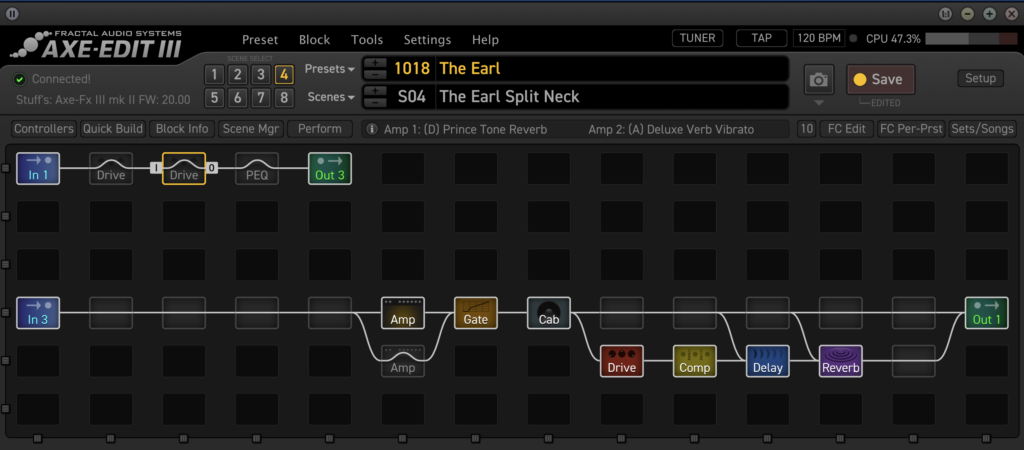
As promised, here’s a screenshot of the amp settings that I used for these audio clips:

This is what the neck pickup on my Telecaster sounds like:
As you can hopefully hear, it’s quite a bright sound, with plenty of bite and a satisfying presence on the top-end. It’s got that unmistakable single-coil sound.
There’s also quite a bit of noise too from electro-magnetic interference. I’ve left that in so that you can hear how the different pickups cope with it.
This is what the neck pickup sounds like on my Stratocaster:
Other than the amount of noise, not a huge amount of difference here. That’s to be expected: the Tele is fitted with Fender’s Twisted Tele pickup set, and that gives the neck pickup a more Strat-like sound.
Finally, this is what the neck pickup sounds like on my Paul’s Guitar when split:
That’s pretty close to my Strat’s neck pickup, isn’t it? I think it sounds a little thicker and a little more aggressive, but it’s definitely in the ballpark.
You can also hear just how noisy the neck pickup is when split. On the recording, it sounds like it’s on a par with my Tele’s neck pickup. In the room, I had to move around a lot more to find a spot where the noise wasn’t even worse.
Using A Drive Pedal To Shape The Tone
I want to take advantage of the thickness of the neck pickup, while smoothing out the aggressive just a little. I’m going to do that by using a Timmy drive in the Axe FX 3.
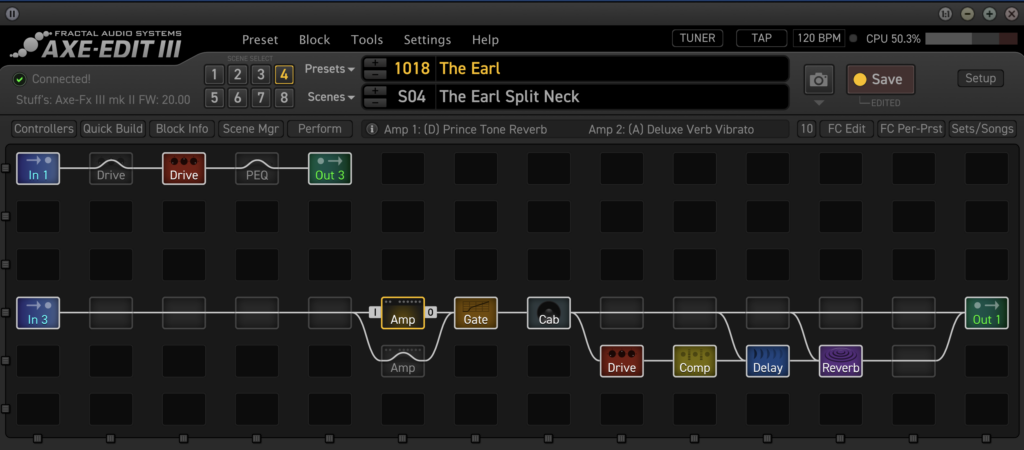


Here’s what my Paul’s Guitar sounds like with this little bit of tone-shaping:
I really like the results. The top-end has been rolled off a little, and it’s taken a bit out of the upper-mids too. I think it sounds a little smoother as a result, a little less jagged. It’s also a little more even, with the extra thickness no longer competing for attention.
Conclusion
Can this Paul’s Guitar stand-in for a Strat’s neck pickup? According to these audio demos, yes, it certainly can.
That was a surprise to me. I’ve spent most of the last four months feeling very negative about this neck pickup on its own. It’s always sounded boomy and dull to my ears.
It’s not just me. At some point in the past (either at the factory or the shop), someone tried to minimise the low-end off the neck pickup by lowing it as far as it would go. When that wasn’t enough, they also tried dropping the screws in the pickup itself.
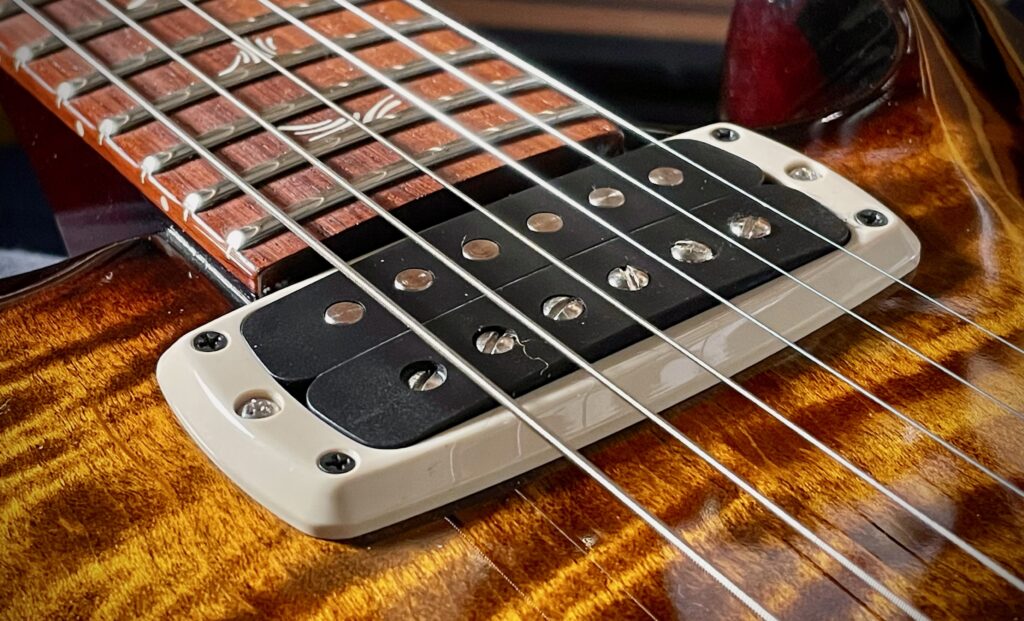
I clearly need to adjust this pickup at some point. I should get some clarity back just by raising the pole piece screws to a sensible height.
Bridge Single-Coil Tones
What about the bridge pickup, when split … is it going to be more Tele-like, more Strat-like, or maybe even its own thing?
Tele vs Strat vs Paul’s Guitar
Here’s my signal chain in the Axe FX 3 for this set of demos:
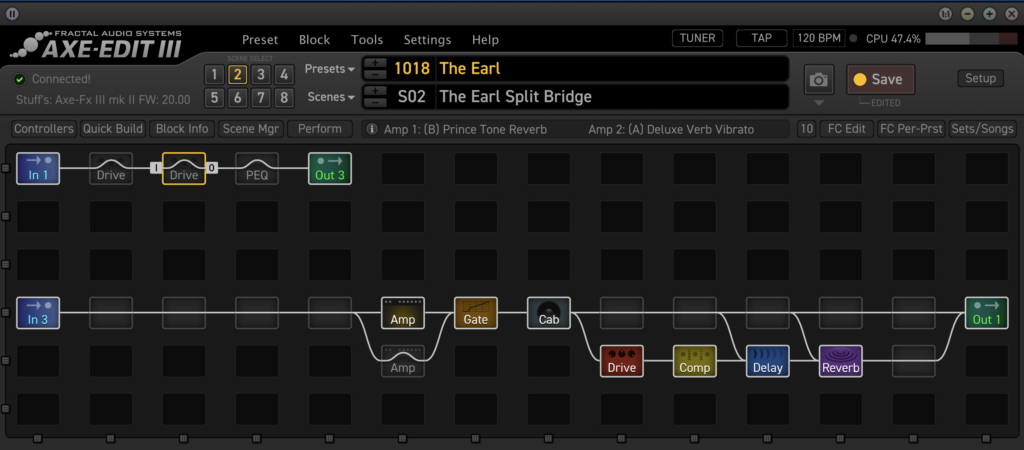
As promised, here are the amp settings I’ve used. They’re pretty similar to what I used with the neck pickup, just with a little less treble and presence:

To start with, here’s how the bridge pickup on my Tele sounds:
Noise aside, that’s a tone that I really enjoy playing through. I love the mid-range that I’m getting there. It’s like a vintage-voiced Les Paul, only with a lot more clarity.
Next up, here’s how the bridge pickup on my Strat sounds:
To my ears, the Strat sounds brighter, more cutting, and thinner. This is not my kind of sound, I’m afraid. Once again, we can also hear how good the Kinman pickups are at handling the noise problems that I currently have!
Finally, here’s the bridge pickup of my Paul’s Guitar, split:
Right off the bat, I think this is closer to the Tele’s bridge pickup than it is to the Strat’s bridge pickup. It’s thicker in the lower-mids, in a way that I think is very satisfying. For the kind of noodling that I enjoying doing, I think I prefer this over the Tele.
What happens if I add some additional processing?
Shaping The Tone Using A Drive Pedal
The Timmy is a great pedal for shaping the tone of a single-coil guitar. For the next demo, I’ve switched it on in the Axe FX 3:
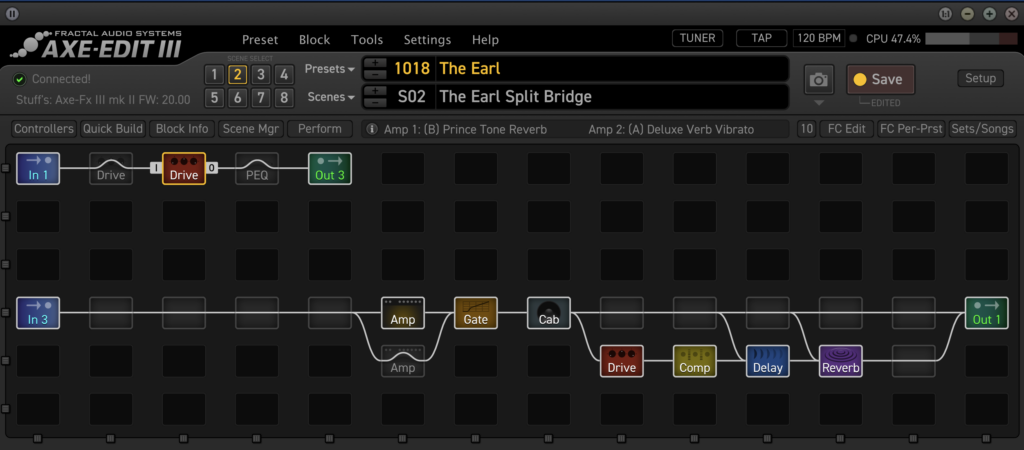


As with the neck pickup, I’m using the Timmy to produce a more even tone. This is going to take me a little ways away from the sound of the Tele:
Shaping The Tone Using EQ Before The Blackbox Overdrive
What if I just want to take out some of the mids, to let the low-mids come through and give me a fatter tone? Maybe that’s a job for a bit of EQ between the guitar and my pedal board.
Here’s the signal chain in my Axe FX 3 for the next demo. I’ve switched off the Timmy Drive, and switched on a parametric EQ instead:

I’ve also adjusted the amp settings, reducing the amount of treble compared to before:

Here are the EQ settings that I’m using for this demo:

Here’s what the end result sounds like.
I like this, because I think it plays to the strength of the bridge pickup. I think it brings out what makes this bridge pickup different to a normal Telecaster bridge pickup.
What do you think? Let me know in the comments below 🙂
Conclusions
Can my Paul’s Guitar stand-in for a Telecaster’s bridge pickup? For the kinds of music I play, absolutely it can. I think the audio demos prove that very convincingly.
To be honest, I prefer this to my Telecaster. I like the extra body that my Paul’s Guitar’s split bridge pickup produces. And I think the Paul’s Guitar is a damn sight more comfortable to hold and play than my Tele is.
Once again, though, susceptibility to noise is something to be aware of.
Both Pickups Single-Coil Tones (aka The Middle Position)
Just like many Telecasters, my Paul’s Guitar comes with a three-way switch. Let’s explore how it sounds in the middle position.
Tele vs Strat vs Paul’s Guitar
Here’s the signal chain that I’m using in the Axe FX 3 for the next set of demos. There’s no tone-shaping going on between the guitars and my pedal board:

Here are the amp settings that I’ve used:

Let’s start off with my Tele in the middle position:
How does that compare to my Strat in the middle position?
I don’t use the middle position on Strats or Teles very much, so I was surprised at how similar they sound. As we’ve heard throughout this blog post, the Tele has a bit more mid-range emphasis while the Strat has a thinner, brighter, more cutting tone.
Is my Paul’s Guitar going to sound closer to the Tele, or closer to the Strat? Have a listen for yourself:
The first thing I noticed was that the noise is finally addressed. I guess that means that the split neck and the split bridge are some sort of reverse-wound, reverse-polarity (RW/RP for short) setup? That could be useful to know if you plan on gigging one of these.
On repeated listenings, I think there’s a big difference between my Paul’s Guitar and the other two guitars.
Conclusions
While I think it’s clear that my Paul’s Guitar has its own thing going on, I couldn’t tell you whether it’s close enough to stand-in for either a Tele or a Strat for that kind of sound. I’m just not someone who uses the middle position on single-coil guitars.
Neck Pickup Humbucker Tones
I’m sorry, I never use the neck humbuckers on any of my guitars. I don’t have a piece of music written for neck humbuckers, so there’s no demo of them here.
Bridge Pickup Humbucker Tones
Even though the narrowfield pickups are humbuckers, they’re marketed by PRS as being voiced like a P90. I’m going to compare it to both an absolutely awesome P90 and my favourite humbucker guitar, so that I can hear for myself.
LPJ vs McCarty 594 vs Paul’s Guitar
For the next demos, here’s the signal chain in the Axe FX 3. There is no tone-shaping going on between the guitars and my pedal board.
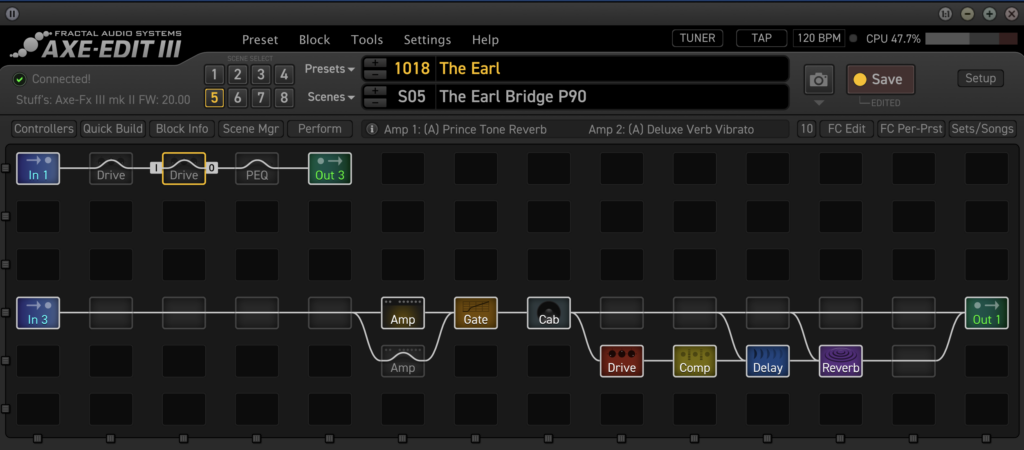
These are the amp settings that I used for all three guitars.

To start with, here’s Morag. It’s a custom-built Les Paul Junior-style guitar that was built for me by Ragh Guitars. It features a single House of Tone P90 pickup at the bridge. It’s the best sounding P90 guitar I’ve ever played.
Man, what a monster of a guitar. And what a monstrous amount of noise it’s picking up too!
The Blackbox Overdrive is still using the same settings that I originally dialled in for my Telecaster and Strat. Instead of adjusting the pedal, I like to roll back the volume and tone a bit instead, to give this sound:
That’s my kind of P90 tone! If my Paul’s Guitar can get anywhere near that, then I’ve finally found my second guitar for double-tracking with Morag.
As with Morag, I’ll start with the volume and tone controls on full.
Wow. Eliminate the noise that Morag is picking up, and I’m not sure I’d be able to tell those two apart in a blind test. They’re not the same – Morag sounds a little thicker to me – but that’s a fantastic result.
And it gets even better if I roll back the volume and tone controls on my Paul’s Guitar too:
For comparison, here’s how the bridge humbucker on my McCarty 594 sounds.
The McCarty 594 has that classic vintage humbucker thing going on, with reduced highs and more emphasis on the mid-range.
Conclusions
The bridge humbucker on my Paul’s Guitar sounds like a fantastic P90 – only without the noise that comes with using a real P90.
The Magic Is In The Middle, With One Pickup Split
I know this has been a long post, so thank you if you’re still with me on this, because I’ve saved the best for last.
I’m sure a lot of people are going to be drawn to the Paul’s Guitar because of what I’ve demoed above: that it can stand-in for Strats, Teles and P90 guitars (at least some of the time). That versatility might be exactly what you’re looking for.
For me, though, the real value is in finding sounds that I can’t get from my Strat, my Tele or my LPJ-style guitar. I’m probably doing all this wrong – I’m not chasing the tones of my guitar heroes. I want to find new ways to express myself with guitar.
And I think my Paul’s Guitar gives me that. Let me demo this to you.
Here’s my signal chain for these demos. This time, I do have a bit of tone-shaping going on between the guitar and my pedal board:

I’m using the Timmy drive model once again, with these settings:


No comparisons with other guitars this time … just my Paul’s Guitar in the middle position, with one pickup split and one pickup on full humbucker.
I love the sound of both of those. If I had to pick, I’d probably go with the first demo (neck humbucker, bridge split) because that split bridge adds a nice touch of clarity. But both are very usable, and I do wonder how they’d work as complementary sounds on a recording.
If You Don’t Have An Axe FX 3
You don’t need an Axe FX 3 to do the kind of tone-shaping that I’ve been doing in these demos.
Until I got the Axe FX 3, I was getting similar results using the MXR Timmy pedal, my MXR 10-band eq pedal, and my Marshall DSL20HR amp. You can also use Wampler’s Tumnus Deluxe pedal to sculpt the tones of the Paul’s Guitar.
The main reason I’m using an Axe FX 3 is because it can be a little tricky to re-create an exact tone when you’re using all-analogue gear. With the Axe FX 3, I can just pull up a preset and know it’ll sound like what I had last time.
Does It Have A Name Yet?
It does. This guitar is going to be called ‘The Earl’, in memory of my late teacher Robert Earl Taylor. I’ll always be grateful for everything he taught me, and everything he encouraged me to do.
Final Thoughts
What is it with me falling for flawed PRS guitars? Because, make no mistake about it, I’ve really fallen for this one.

Whats a fantastic review. Very helpful. Amazing, thanks you!
Hi, Great post, those demos really tell the story! I find with these pickups (and most PRS pickups) the secret for more vintage tone is using the last bit of the volume knob as a last resort. I love the middle of the volume knob on my 408s
I had the same issues with my PRS Paul’s core guitar …. there was a hum unless I touched the strings or pickups .. something to ground it.
I contacted PRS and they had me send it to them free of charge and they fixed it. .. came back with no hum.
The explanation was Paul thinks the guitar sounds better with it being ungrounded.
I found the hum annoying .. and didn’t notice any difference in sound when it came back from PRS.
PRS was the best to deal with.
That’s interesting. Mine has been back to PRS, but they said there was nothing to fix. The big problem I’ve got is lots and lots of static noise. I’m going to do a full blog post on it when I’ve reached the conclusion of that particular story.
Thanks for documenting and sharing this info! Hearing the tone comparisons is invaluable. I own a few PRS DGT’s and a Studio. I ordered a Paul’s guitar because I think it will complement the guitars I already own.